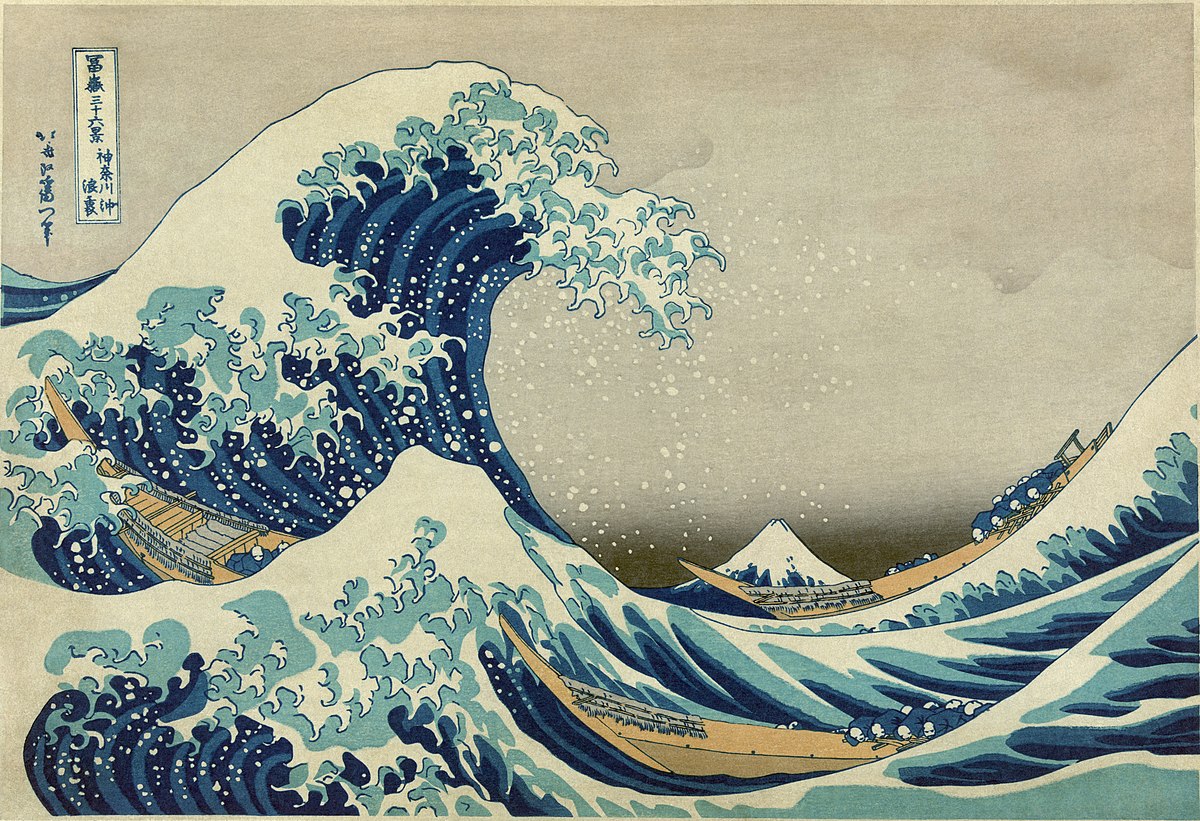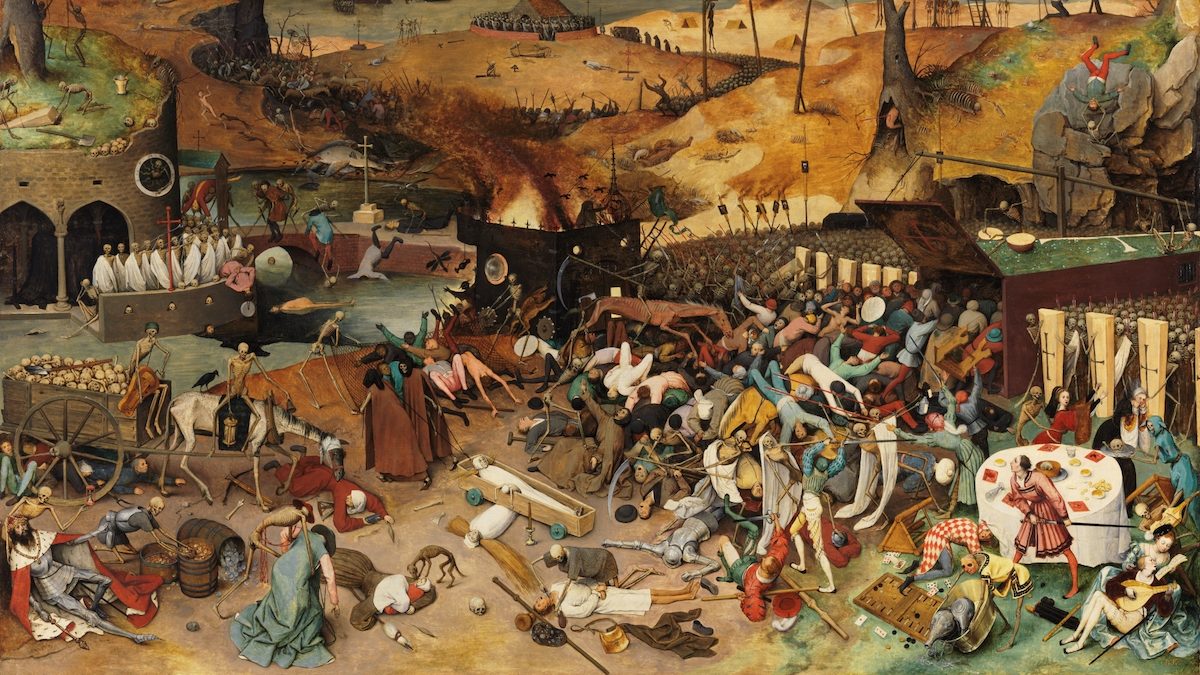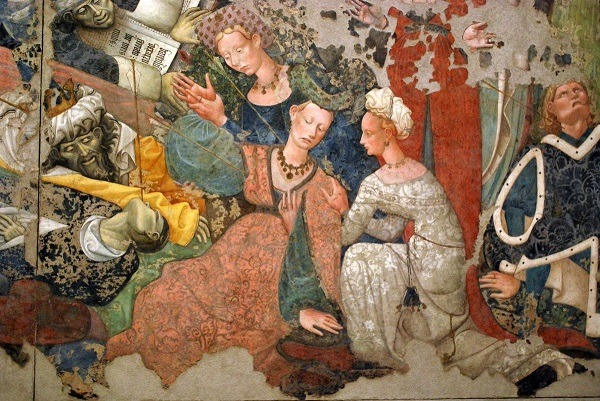Renaissance
The Renaissance (meaning rebirth) was a cultural movement that started in Italy in the fourteenth century and spread throughout Europe. In art, the style of painting became highly realistic and attempted to mimic nature as closely as possible.
- What to look for: a rich three-dimensional perspective, human subjects in proportion (usually wearing robes and making grand gestures), and convincing representation of spaces.
Baroque
The term Baroque is often applied to the art of the whole of the seventeenth century, and the first half of the eighteenth century. Painters expanded on the naturalistic tradition established during the Renaissance, and extended their subjects to include landscapes, and still life. Baroque painters often set their subjects in vast landscapes, or interiors with extended views through doors, windows, or mirrors.
- What to look for: melodramatic spaces, fat cherubs, light rays, and fruit bowls.
Rococo
Rococo was a decorative art that originated in France in the early eighteenth century and is marked by elaborate ornamentation, with a profusion of scrolls, foliage, and shell-like forms.
- What to look for: paintings of the aristocracy at play, asymmetry to composition, many small-scale ornamental details, and pastel colors.
Neo-Classicism
During the Neoclassical period (mid-eighteenth century), the work of the Greeks and Romans (pre- Renaissance) became popular again, and paintings depict historical subjects.
- What to look for: paintings with sharp outlines, cool colours, armour, spears and sandals.
Romanticism
Romanticism is assumed to be in opposition to Neoclassicism, and the term used to refer loosely to a trend in art of the late eighteenth and early nineteenth centuries. It was characterized by the avoidance of classical forms and rules, emphasis on the emotional and spiritual, nostalgia for the grace of past ages, and a fondness for exotic themes.
- What to look for: complex compositions, intense colour, soft outlines and heroic or scantly clad subjects.
Realism (1850 – 1880)
Realism came about in France during the Industrial Revolution. Realist Artists attempted to create objective, accurate, detailed, and unembellished representations of the external world based on the impartial observation of contemporary life. The name Realist refers to their subject matter; humble citizens doing everyday work and previously considered unworthy of representation in high art, rather than mythical heroes, Biblical or classical subjects, and portraits of the rich.
- What to look for: paintings of poor people working.
Pre-Raphaelites (1848)
The Pre-Raphaelite Brotherhood was a group of young English artists who rebelled against the style of the day that was being taught at the Royal Academy and other art schools. They felt the art was dark and muddy in color, and the subject matter artificial. They admired the work of the artists of the fifteenth century, and their name, the Pre-Raphaelite Brotherhood, honored the depiction of nature in Italian art before “Raphael”.
Pre-Raphaelite artists believed art should have a serious, moral purpose and often filled their work with symbols suggesting deeper meaning. Most of all, they believed in artistic excellence. To give their paintings a lighter, fresher look, they used bright colors and painted on a white canvas, rather than a brown one. While the Pre-Raphaelite Brotherhood lasted less than ten years as a group, other artists carried on with the style, which became broader and more muted in color.
- What to look for: subjects taken from the Bible, Shakespeare, and the legend of King Arthur. Paintings exhibit meticulous detail, intense colors, tight handling of paint, and complex compositions. Many works are highly realistic.
Impressionism (1860 – 1900)
The Impressionists were a group of French artists discontent with academic teaching, and who shared approaches, and techniques. They abandoned traditional formal compositions in favor of a more casual and less contrived arrangement of objects within a picture.
The identifying feature of their work was an attempt to record a scene accurately but without the use of traditional muted browns, greys, and greens in favor of a lighter, more brilliant palette. They stopped using greys and blacks for shadows and used short (visible) brush strokes to produce flecks of unblended pure colors. They cast off literary and anecdotal subjects in favor of candid portrayals of ordinary people (doing regular things in everyday locations), landscapes, and architecture. Indeed, they rejected the role of imagination in the creation of works of art. Their name derives from a criticism of the first “impressionistic” work publicly displayed.
- What to look for: paintings look normal from far away, but close up they are a bit of a mess. Also, look for the same image painted two or more times under different lighting conditions.
Post-Impressionism (1860 – 1905)
Post-Impressionist was not a cohesive movement, and the style of individual artists vary. Post-Impressionism was simultaneously an extension of Impressionism, and a rejection of its concern for the naturalistic depiction of light and color in favor of an emphasis on abstract qualities or symbolic content. Post-Impressionists continued using vivid colors (e.g. Cézanne painted red grass), thick application of paint, and distinctive and visible brushstrokes.
- What to look for: You see paint first, and the image second.
Abstraction
Abstraction is a generic term for art that does not represent recognizable objects. Abstractionists abandoned art as the imitation of nature in favor of imagery from the imagination and the unconscious. Abstraction comprised a number of different movements, such as Fauvism, Cubism, Futurism, Dada, Surrealism, and Expressionism.
- Fauvism (1905 to 1907), as a movement, had no concrete theories. The name derives from the judgment of a critic who referred to the artists disparagingly as “Les Fauves” (wild beasts). Fauvist artwork is characterized by distorted forms, bold and vivid colors, often applied unmixed, and spontaneity and roughness of execution. Fauvism was short-lived, and most practitioners became Cubists.
What to look for: You may say to yourself, “I could do that.”
- Cubism (1907 to 1914) retreated from traditional perspective in favour of geometric forms. It attempted to achieve the illusion of three-dimensional forms in a different way by showing many aspects of familiar objects all at once from many vantage points to create new combinations.
What to look for: You may ask yourself, “What is it?”
- Futurism(1909) was an Italian movement with the intention to reject tradition ideals, and celebrate the aesthetic generated by the speed and power of the machine, and the energy and restlessness of modern life. Futurists adopted the Cubist technique of depicting several views of an object simultaneously with fragmented planes, and used rhythmic spatial repetitions of the object’s outlines in transit to render movement. Their preferred subjects were machines, and urban crowds. Their palette was more vibrant than the Cubists’.
What to look for: You may ask yourself, “What is it?”
- Dada (1916–1923) was initially a Swiss movement that channeled their revulsion at World War I into an indictment of the values that had brought it about. They were united not by a common style, but a rejection of conventions in art. Through unorthodox techniques, they sought to shock society into self-awareness. The name Dada itself was typical of the movement’s anti-rationalism. Various members of the group are credited with selecting the name for its childish and nonsensical connotations.
What to look for: You could be forgiven for not recognizing a Dada exhibit as art (e.g. Duchamp “improved” the Mona Lisa by drawing a mustache on her).
- Surrealism (1924) flourished in Europe between World Wars I and II, and grew principally out of the earlier Dada movement, and was similarly a reaction against the “rationalism”. It attempted to join fantasy and everyday reality to form a new reality, and drew on the theories of Sigmund Freud, that the unconscious was the source of the imagination. Many different forms of Surrealism developed, including the realistically painted images of Salvador Dalí.
What to look for: something that simultaneously looks real, and unreal.
- Expressionism: was an art movement of the early twentieth century in which traditional adherence to realism and proportion was replaced completely by distorted color and form to emphasize and express the intense emotion of the artist.
What to look for: dribbling, drippy paint splattered on the canvas.
The 90s also have a lot of interesting art movements that are lost today. Read about art history on my blog about oil painting. After exploring the transformative art movements that shaped centuries, it’s intriguing to examine their influence on modern social dynamics. In How Did the 2000s Influence Today’s Social Movements?, we trace how the cultural and artistic expressions of the early 21st century have impacted and inspired the social and activist movements that are shaping our current societal landscape



